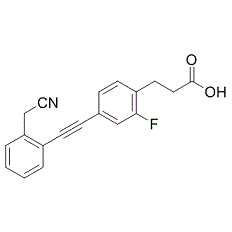| Cas No.: | 1402601-82-4 |
| Chemical Name: | 3-[4-[2-[2-(cyanomethyl)phenyl]ethynyl]-2-fluorophenyl]propanoicacid |
| Synonyms: | TUG770; TUG 770 |
| SMILES: | C1=CC=C(C(=C1)CC#N)C#CC2=CC(=C(C=C2)CCC(=O)O)F |
| Formula: | C19H14FNO2 |
| M.Wt: | 307.32 |
| Sotrage: | 2 years -20°C Powder, 2 weeks 4°C in DMSO, 6 months -80°C in DMSO |
| Description: | TUG-770 is a highly potent free fatty acid receptor 1 (FFA1/GPR40) agonist with EC50 of 6 nM for hFFA1. |
| In Vivo: | Examination of TUG-770 in an acute intraperitoneal glucose tolerance test (IPGTT) in normal mice revealed a good dose dependent response with maximal reduction in glucose level reached at 50 mg/kg. The effect of TUG-770 was fully sustained after 29 days of daily oral treatment. Additional evaluation of TUG-770 in rats confirmed a significant glucose lowering effect for the high doses already after 10 min and for all doses after 30 min [1]. |
| In Vitro: | TUG-770 (Compound 22) displayed excellent physicochemical and in vitro ADME properties, with good aqueous solubility, good chemical stability, low lipophilicity, and decreased plasma protein binding (PPB). TUG-770 furthermore showed excellent stability toward human liver microsomes (HLM), no inhibition of selected CYP-enzymes implicated in drug-drug interactions, no P-glycoprotein (P-gp) inhibition, and good permeability in the Caco-2 cell assay [1]. |

 To enhance service speed and avoid tariff delays, we've opened a US warehouse. All US orders ship directly from our US facility.
To enhance service speed and avoid tariff delays, we've opened a US warehouse. All US orders ship directly from our US facility.





















